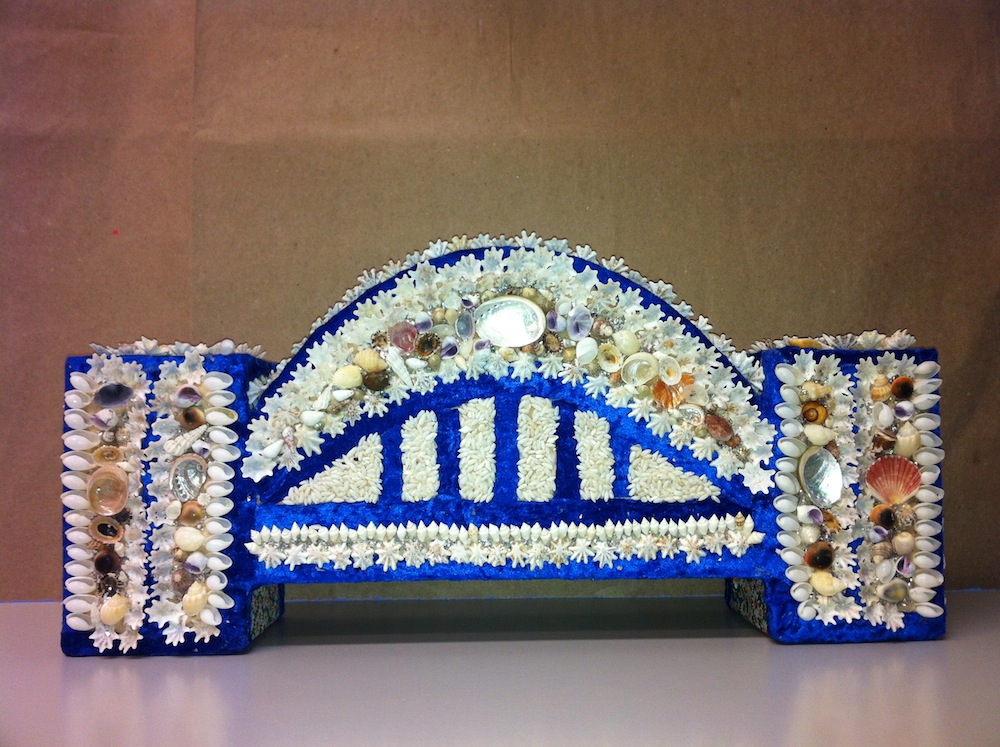
Esme Timbery Russel and Marilyn Russel – Sydney Harbour Bridge, 2013
Approx. 54 x 25 x 12 cm – Shells, glitter, glue, paper, plywood
La Perouse community, Central NSW
‘La Per Shellwork’
The shell work of the Timbery and Russell families, Bidjigal people of La Perouse, carries within it stories of invasion, displacement, adaptation and cultural revival. It speaks of skills and traditions passed from generation to generation of Bidjigal women of this historic area, La Perouse, the birthplace of Australia.
After all it was the not so distant relations of these Aboriginal families of La Perouse who were fishing on the boats at Yarra Bay when Captain Cook and his crew dropped anchor off Kurnell (Kurmay) and came ashore in April 1770, claiming the land for the British Empire. The same Bidjigal people watched the French ships, l’Astrolabe and La Boussole sail into Botany Bay eight years later under the command of Jean-Francois de Galaup, Comte de La Perouse who south refuge in what is now known as Frenchmans Bay.
In many ways the shell work of La Perouse could be called the first and oldest Aboriginal art movement in Australia. Accounts from as far back as 1880 describe Aboriginal men making and decorating clubs and boomerangs and women decorating these weapons and other objects with shell work to sell to tourists who visited this historic area.
In 1885 an Aboriginal Reserve was established in La Perouse. This saw the return of Aboriginal families to the area and the growth of this arts and crafts tradition.
The Bidjigal women of La Per women have been earning an income from shell work for generations.
By the 1940’s Esme Timbery, born in 1931, and her sister Rose joined the shell working sorority. It was Esme who was commissioned to make a piece of the Sydney Opera, which was purchased by the Opera House. Esme, now in her 80’s, has been represented in exhibitions since 1977 and is in National and State museum collections across Australia, such as the National Museum of Australia, the Art Gallery of NSW and the Museum of Contemporary Art in Sydney. In 2005 she won the NSW Parliament Indigenous Art Prize.
This ongoing practice of shell work has recontextualised the souvenir as an encounter. The object becomes metonymic of a lived experience. Esme’s daughter Marilyn Russell is now continuing the tradition of La Per shell work.
The two pieces here are collaborations by Esme and Marilyn. They say their shell work is a continuation of Bijigal artistic practice and a very important healing practice. It gives them a context within which to reflect upon their past and to share personal and traditional stories. “It makes us feel strong” says Marilyn. “I’m always happy when I am working with my shells”, says Esme.
Aboriginal curator and academic, Hetti Perkins says ” this work interrogates what is and what isn’t Aboriginal art… it challenges stereotypes… what’s contemporary… what’s traditional… what’s art…. what’s craft… how craft becomes collectible art.
Catherine Hickson
About the Author:
Catherine Hickson, Curator Special Projects at IDAIA.
Artworks © The Artists, Photo © IDAIA